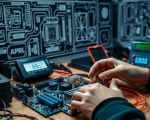How to Repair and Upgrade an Old Computer: A Complete Guide
If you're like me, you probably have an old computer sitting around that has been collecting dust for years. Maybe it's sluggish, keeps crashing, or just doesn’t seem to work the way it used to. Instead of ditching it and buying a new one, why not consider repairing and upgrading your old computer? With a little patience, the right tools, and some know-how, you can breathe new life into your aging device. Here’s a detailed guide on how to repair and upgrade your old computer to make it run faster and more efficiently.

Action Computers Inc. -- Denver Location
2890 S Colorado Blvd F, Denver, CO 80222, USA
1. Identifying Common Problems with Old Computers
Before diving into repairs, it's important to identify the most common issues that affect older computers. These can include slow performance, frequent crashes, overheating, or hardware failures. By diagnosing the root cause, you can decide whether it's worth repairing or if certain parts need upgrading.
The first step is to run basic troubleshooting. If the computer is extremely slow, it could be due to too many background processes or lack of storage space. A failing hard drive or memory issues can also cause these symptoms. Regular system freezes might be caused by overheating or outdated drivers. You can usually find solutions by checking the Task Manager for memory hogs or cleaning up unnecessary files.

Fix It Computer Repair
2638 Geranium Ln, Fort Collins, CO 80525, USA
2. Upgrading Your Old Computer’s Storage
One of the most effective ways to improve an old computer's performance is by upgrading the storage. If your computer is still using a traditional hard disk drive (HDD), upgrading to a solid-state drive (SSD) can significantly speed up your machine. SSDs have become more affordable and offer faster boot times, quicker file access, and increased durability.
Swapping out your old hard drive with an SSD is a great way to revive an old computer. Most desktops and laptops can easily accommodate a new SSD. Just ensure that the SSD is compatible with your system and that you back up your data before you begin the installation process. After installation, reinstalling the operating system on the SSD will provide a fresh start and optimal performance.
3. Adding More RAM to Boost Performance
If your old computer is constantly running out of memory, adding more RAM (Random Access Memory) can help alleviate the problem. RAM is essential for handling multiple tasks simultaneously, so if your computer has less than 8GB of RAM, it might be time to upgrade.
Before purchasing new RAM, check the specifications of your motherboard to determine how much RAM it can handle. Installing new RAM is typically easy and inexpensive. You can add additional RAM or replace the existing sticks with higher-capacity ones. Keep in mind that matching the type, speed, and capacity of your existing RAM is crucial to ensure compatibility.
4. Fixing Common Hardware Issues
Older computers often suffer from hardware-related problems, such as a damaged power supply, malfunctioning keyboard, or faulty motherboard. Diagnosing these issues can be tricky, but with some basic troubleshooting, you can identify the problem.
Start by checking for loose or disconnected cables, as a simple connection issue can cause your computer to power down unexpectedly. If you hear unusual beeping noises or if your computer doesn’t turn on, the motherboard or power supply might be the issue. In some cases, you may need to replace the faulty hardware. Luckily, many components, like power supplies, keyboards, and even motherboards, are readily available for purchase online.
5. Cleaning and Maintaining Your Old Computer
Over time, dust and dirt can build up inside your computer, causing it to overheat or run inefficiently. Regular cleaning can prevent these issues. Start by turning off your computer and unplugging it from the power source. Use a can of compressed air to blow out dust from the vents, fans, and inside the case. Make sure to clean the CPU fan and the graphics card as well, as these components tend to accumulate dust the most.
In addition to cleaning, it’s important to perform regular maintenance, such as updating your operating system and drivers. Outdated software can lead to performance issues or even security vulnerabilities. Regular updates help ensure that your computer is running smoothly and securely.
6. When to Consider Professional Help
While upgrading and repairing an old computer can be a fun and rewarding DIY project, there are times when you may need to seek professional help. If your computer is experiencing severe hardware failures, such as a dead motherboard or unfixable power supply, it might be more cost-effective to consult a professional repair technician.
Professional repair services can help diagnose and fix complex issues that are beyond your skillset. They also provide more extensive support, especially if you’re dealing with data recovery or hardware upgrades that require specialized tools. If you’re unsure about whether to attempt a repair or upgrade yourself, don’t hesitate to ask for expert advice.
Conclusion: Breathe New Life into Your Old Computer
Repairing and upgrading an old computer is a great way to extend its lifespan and improve its performance. By replacing outdated parts, adding more storage and RAM, and keeping everything clean and updated, you can get many more years of use from your device. Whether you choose to do the repairs yourself or consult a professional, taking action will ensure that your computer remains functional and efficient.
If you’re unsure where to begin or if you need professional repair assistance, check out our website, Computer Repair, for expert advice and services tailored to your needs. Don’t let an old computer hold you back—give it a new lease on life today!





























